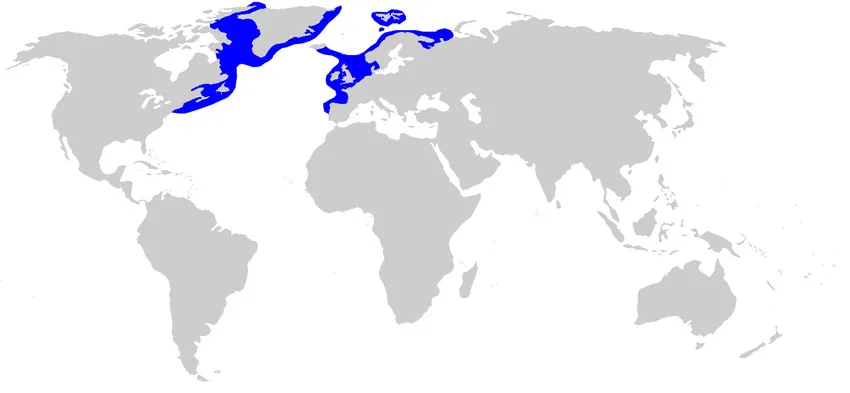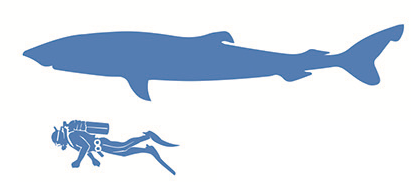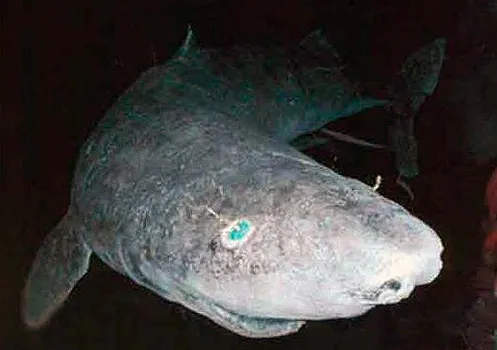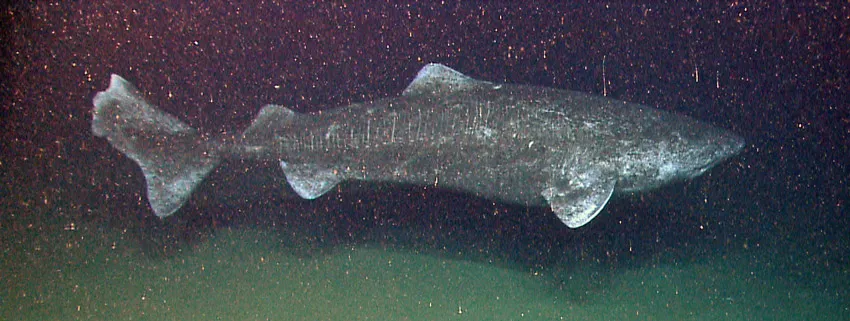Greenland Shark - Facts and Adaptations
Somniosus
microcephalus
The largest fish in the Arctic, so strange as to be almost other-worldly. Greenland sharks live mainly in the ocean depths and like some other cold blooded Arctic animals live life in slow motion - for hundreds of years, they are the longest living vertebrates known.
Greenland shark facts Basics
Like many creatures of the deep seas, little is known about the biology of the Greenland shark. They are rarely seen and difficult to study in the seas usually being caught as a by-catch by trawlers or sometimes caught as a target species, though less so now than in the past when they were heavily fished for their liver oil for lamp fuel and as a lubricant.
Picture: It is only in recent years that remotely operated underwater vehicles with cameras have filmed Greenland sharks in the depths where they live..
Weight and length : Greenland sharks are thought to continue growing through their lives, so there is no "average" adult size as for other animals that stop growing after a while (like humans). They are large fish, one of the biggest shark species and the largest fish in the Arctic.
Typically they are in the range of about 2.4 - 4.8m (8 - 15.7 ft) and up to around 400kg (880lb). They can grow larger than this to 6.4m (21ft) and 1 000kg (2 200 lb.) possibly larger. They are thought to grow at the rate of about 1cm per year.
Breeding: Greenland sharks are thought to not reach sexual maturity until they are 150 years old. They are ovoviviparous meaning that they retain the eggs within their body until they are ready to hatch when the young are born. The gestation period is unknown, a 5m (16 ft) female was found with 10 full-term young 38-42cm (15 - 17 in) in length.
Estimated world population: Unknown, they were heavily fished in the early 20th century up to the 1960's when sometimes more than 30,000 were caught in a single year. They are fairly easy to catch if fishermen make the effort to do so indicating that they are fairly common.
Feeding & diet: There is much evidence to show that Greenland sharks will eat just about any carrion they encounter, all manner of fish have been found in their stomachs along with the remains of whales, seals, dogs, horse, reindeer, moose and polar bears.
Greenland sharks are slow moving animals with low metabolisms, it is unclear as to how effective they are as predators and which of the prey items found as stomach contents were already dead when eaten or were hunted and taken as prey. They have not been seen directly hunting and eating seals for instance, though they have been seen following divers in a way that is indicative of a seal hunter. It is assumed that mainly they are opportunistic ambush predators eating almost everything they encounter and have an opportunity to eat. They are thought to eat sleeping seals in the sea where they are trying to avoid polar bears on land or the ice.
Conservation status - Near Threatened, though there is little recent data to be certain about this.
Distribution: Greenland sharks like frigid waters and are only seen near the surface rarely and then when the surface water is cold enough which mainly means in the Arctic. They are most commonly seen around Greenland and Iceland and have been assumed to be purely polar animals. The deep waters around the globe are very cold however, at 4C (40F) and it has recently been suggested that these sharks are much more widespread than previously thought. They have been seen around the coasts in Northern Europe and North America, Scandinavia, Scotland, Canada and down to Portugal and France, they could be anywhere that is deep and cold enough.
They live at depths down to 1 200m (3 900 ft) and have been reported down to 2 200m (7 200 ft).
Predators: Being such large fish, Greenland sharks are not threatened by very much at all. There are two reports of a sperm whale feeding on them off the coast of Canada, it is thought this was an individual that specifically chose this prey with the result that the teeth were significantly worn down to the gum line as a result of dealing with hard abrasive shark skin.
 Currently
known distribution range of Greenland sharks
Currently
known distribution range of Greenland sharks
picture used courtesy Chris huh,
under
CC BY-SA 3.0 licence
What are Greenland sharks like? how do they survive?
 Ancient,
slow and largely unknown pretty much sums up the Greenland shark.
Ancient,
slow and largely unknown pretty much sums up the Greenland shark.
They are the slowest swimming fish species for their size with a normal cruising speed of about 30cm or a foot a second, 1.2 kmh (3/4 of a mph) rising to a fastest cruising speed of just over twice this, just about anything they might want to eat swims faster than them. This correlates with their low metabolism and extremely long lives, they live a long time, largely it seems by doing it all in slow motion.
Greenland sharks are longest lived vertebrates, this was first suspected when in 1952 an individual was recaptured off Greenland that had been previously caught and tagged in 1936, it had grown at the rate of about 1cm a year in the intervening years. These sharks have soft cartilaginous skeletons without the hardened calcification of the vertebrae that is found in other large sharks which enables their age to be determined.
In 2009 it was found that these sharks lay down crystalline structures in the lens of their eyes which could be carbon dated to determine their age, such a technique by its nature gives a range of potential age rather than a single figure. A study of samples from 28 individuals killed as by-catch from trawlers or Greenland fishermen determined that the largest fish, a 5m (16 ft) female was 392 ±120 years old. That is, it was at least 272 (392-120) years old and up to 512 (392+120) years old. Even the lower estimate makes it the oldest vertebrate.
Greenland sharks live in cold water which is found in the Arctic right up to the shallows, especially in the winter, but also in the ocean depths away from the poles. They may be seen in the shallows in their range during the winter months at the Saguenay Fjord, eastern Canada, and Qaanaaq, NW Greenland, they have been encountered by divers many hundreds of times in Baie-Comeau, QuÃ� ’©bec, also in Eastern Canada. They have been seen by remotely operated cameras at great depth well away from the Arctic and may be more common in such places than has been thought, without a fishery or regular monitoring, they could just be overlooked.
 What's
that thing on their eye?! Most Greenland sharks have
a parasite that infects them on one eye, it is a copepod Crustacean
(called Ommatokoita elongata) related to crabs and
lobsters but greatly reduced in form due to its parasitic lifestyle.
It trails backwards as the shark swims and ends up making the
shark blind, though this doesn't make much difference as
they can still see light and dark, though where they live predominantly
in the ocean depths is so dark that it makes little difference
to them. There have been suggestions that the parasite provides
some function to the shark, though there is no evidence that
it is anything other than a parasite.
What's
that thing on their eye?! Most Greenland sharks have
a parasite that infects them on one eye, it is a copepod Crustacean
(called Ommatokoita elongata) related to crabs and
lobsters but greatly reduced in form due to its parasitic lifestyle.
It trails backwards as the shark swims and ends up making the
shark blind, though this doesn't make much difference as
they can still see light and dark, though where they live predominantly
in the ocean depths is so dark that it makes little difference
to them. There have been suggestions that the parasite provides
some function to the shark, though there is no evidence that
it is anything other than a parasite.
Toxic flesh. Greenland sharks have high levels of the chemicals urea and trimethylamine oxide throughout their bodies which makes them toxic if eaten without processing first, the effect is similar to extreme alcoholic intoxication. It can affect humans and also sled dogs if it is fed to them resulting in death if too much is consumed. The flesh can be made safe by drying, fermenting or boiling in several changes of water.
Greenland shark flesh can be consumed and fed to sled dogs safely if it is treated correctly first.
In Iceland, there is a traditional delicacy called Hakarl made from these sharks which traditionally have been buried in gravel near the beach for 6-12 weeks, the weight of the gravel and large stones placed on top press out the fluids and the flesh ferments. Once dug up again, the flesh is cut into large pieces and dried in the open air for 4-5 months before being cut into small cubes to be eaten with a toothpick.
There are many descriptions of what Hakarl is like to eat, it's one of those foods that brings people out in inventive turns of phrase to describe how utterly disgusting it is. I tried some in Iceland a few years ago and while I won't bother to ever eat any again, it wasn't so bad. It reminded me somewhat of rather too old and somewhat off stinky cheese, like a piece of stilton or gorgonzola that had gone over the top and while still being edible, you wouldn't choose to eat it (I love stilton and gorgonzola). I can see how it might become an acquired taste especially accompanying a shot of local spirit as it is intended to be consumed. It smells much worse than it tastes apparently, but I missed that part out as our guide picked it up and popped it quickly in his mouth so I did the same, probably a good move. In the past when imported foods were much more uncommon than they are now, I can see how the Icelanders with relatively little variety of food that grew or could be caught locally, it would be a welcome addition to what was available, it is becoming less commonly eaten, particularly by the young.
Greenland Shark Adaptations:
- Large quantities of urea and trimethylamine
oxide in the body (physiological) - many marine
fish are constantly expending energy to balance the amount
of water and salt in their body, the presence of high urea
concentrations in the body fluids means that water balance
can be maintained without expending energy.
A downside of this is that high urea concentration is detrimental
because it destabilizes proteins (urea is one of the main
components of urine that our kidneys remove from our blood).
To counteract the effect of urea, sharks also have trimethylamine
oxide in their body fluids which itself has other benefits
in that it acts as an antifreeze (along
with urea) and aids buoyancy.
- Excellent sense of smell (physiological)
- being almost blind because of those eye parasites and
living in the dark depths of the ocean anyway where there
is no light, the sharks use their excellent smell to seek
out prey and carrion to feed on.
- All the usual anatomical fish adaptations
- fins for swimming, gills for breathing in water, a streamlined
shape, a typical heterocercal shark tail fin larger at the
top than the bottom to prevent sinking when swimming as
sharks don't have a swim bladder to keep them buoyant.
- Dermal denticles (anatomical) - dermal
- skin, denticle - tooth-like. Like all sharks, the whole
skin is covered with tiny tooth-like projections which reduce
drag when the shark is swimming, counter-intuitively these
tiny protuberances reduce turbulence more than if the skin
was smooth.
- Large spiracles behind the eyes (anatomical)
- these are holes that are vestigial gill slits, not all
sharks have them and they are larger in the Greenland shark
than other species. They allow the sharks to get oxygen
from the water while swimming more slowly to conserve energy.
Picture use: Top of page, NOAA. / Shark and diver - Creative Commons Attribution Share alike International 4.0 license / Shark with eye parasite - Creative Commons 2.0 license

